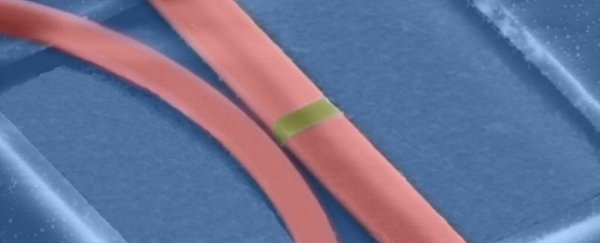Scientists in the UK have developed the first ever memory chip that's entirely light-based and can store data permanently, and it could one day allow us to send and receive data at the speed of light.
Light-based computers are increasingly looking like our best shot at clearing the biggest roadblock to faster computers: the von-Neumann bottleneck. Right now, the speed at which our computers transmit data is slower than the speed at which they can process it, because we've hit the limit for how fast electrons can travel between the processor and the memory.
"There's no point using faster processors if the limiting factor is the shuttling of information to-and-from the memory - the so-called von-Neumann bottleneck," one of the researchers, engineer Harish Bhaskaran from the University of Oxford, said in a press release. "But we think using light can significantly speed this up."
Making light-based computers isn't as simple as replacing electrons with light particles - or photons - in current computers. While this speeds up the rate at which we can send data significantly, the silicon chips we have now still require the photons to be converted back to electrons when the data reaches our computer. This slows everything back down again and consumes a whole lot of extra energy, which actually makes it less efficient than if we'd just used electrons in the first place.
Instead, we need to completely redesign the way our computers work, running them on light instead of electricity, and this new light-based computer chip brings us one step closer to that goal.
Known as photonic memory, light-based memory is not a new concept, but it's posed quite a challenge to engineers in the past. Not only have previous attempts at light-based computer chips turned out to be quite volatile, they've all required power to store data, and unless we're prepared to keep our computers on, you know, forever, that's not exactly practical.
Bhaskaran and his colleagues have now announced what they're calling "the world's first all-photonic nonvolatile memory chip". It stores data using the same material that's found in rewritable CDs and DVDs - a phase-change alloy of germanium-antimony-tellurium known as GST. "This material can be made to assume an amorphous state, like glass, or a crystalline state, like a metal, by using either electrical or optical pulses," the press release explains.
"These two states have very different physical properties," Bhaskaran explained to Jamie Condliffe at Gizmodo. "And that means you can store information in the state of the material."
The chip is built by placing on a small section of GST on top of a silicon nitride ridge - known as the waveguide - which carries the photons to where they need to go. "Think of the waveguide as a kind of miniature fibre optic cable that can carry light: pulses of a laser can be sent down the guide, where they can interact with the GST and then continue out to the other end," says Condliffe.
Publishing in Nature Photonics this week, the team explained how they could send intense pulses of light through the waveguide to change the state of the GST, causing it to momentarily melt and then cool down and achieve an amorphous structure. A slightly less-intense pulse could be used to change the GST to a crystalline state.
Once this is done, a much lower intensity pulse of light is sent through the waveguide, and the amount of light that's transmitted from one end to the other will depend on what state the GST is currently in. The difference can then be used to replicate the 1s or 0s you'd find in normal memory, Gizmodo reports.
"This is the first ever truly non-volatile integrated optical memory device to be created," one of the team, Carlos Ríos, said in the press release. "And we've achieved it using established materials that are known for their long-term data retention - GST remains in the state that it's placed in for decades."
The team is now trying to figure out how to redesign the rest of the computing architecture so their light-based memory chips can directly interact with the other components using light, rather than electrical signals. "You have to solve one problem at a time," Bhaskaran told Gizmodo.
